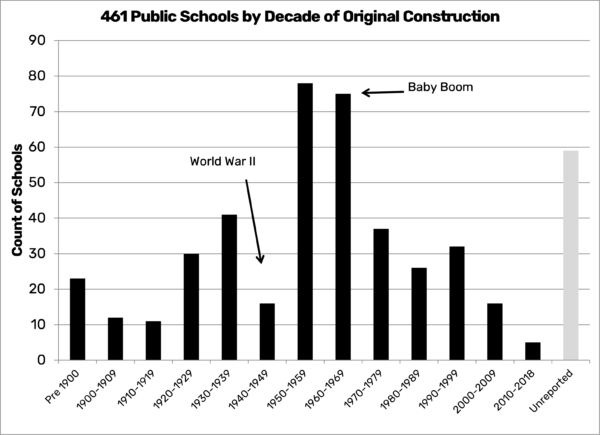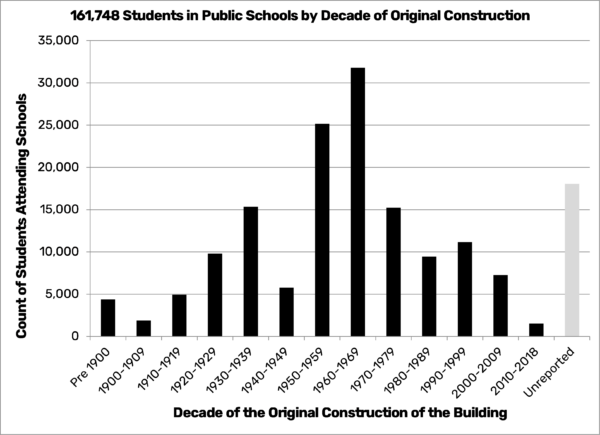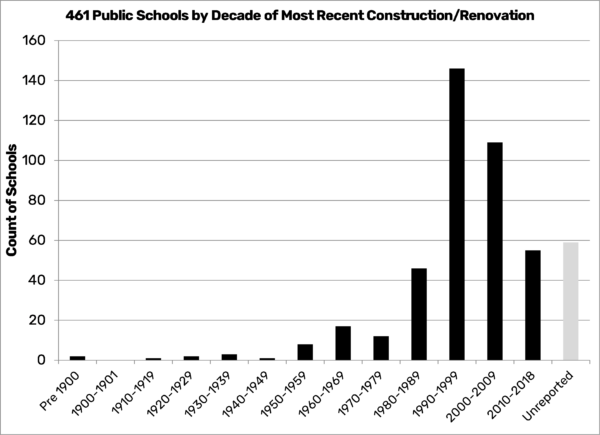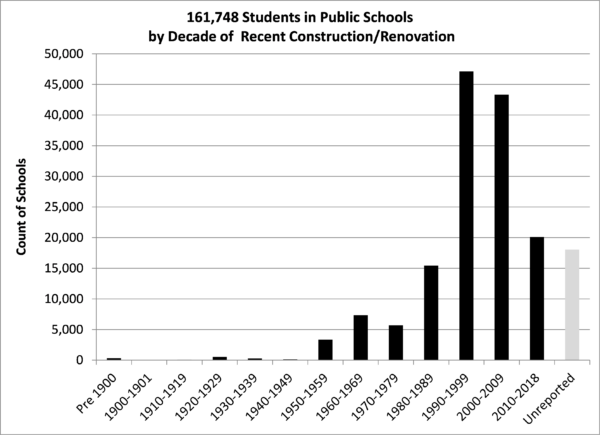Beyond teachers, curriculum, and school supplies, our public school students in New Hampshire rely on safe facilities to foster happy and healthy learning environments. To keep our schools up to safety standards, school buildings need to be updated, rebuilt, and refurbished. These necessary construction projects come at a large price. Unfortunately, many of New Hampshire’s communities cannot afford to take on such projects on their own, and the system in place does not meet the complex needs of all our schools and students.
Key Findings:
- 33,160 (20%) NH students are in buildings that have not been updated in 35 years.
- 42% of New Hampshire’s public school buildings were originally built before 1950.
- 67% of New Hampshire’s public school buildings have been updated in some capacity in the last 35 years.
- The only districts that have buildings that have not been updated in the last 40 years have below-average Equalized Value Per Pupil.
- Asbestos and Lead are found in 24% of New Hampshire’s public schools. Several have not received building aid from the state in the past 15 years.
- The need for building aid in New Hampshire outweighs the budget allotted for building aid for the 2024-2025 biennium.
- Mandatory school conditions surveys for New Hampshire’s public schools that provide the necessary information for the Department of Education and lawmakers to meaningfully understand building aid issues are needed.
Background
The State of New Hampshire only provides, on average, $4,700[1] per student to public schools to provide an adequate education. Schools spend, on average, $20,000. There are many items not included in the State’s calculated cost of an adequate education, including financial support for school buildings.
When a school district decides that it will need to take out a bond for major improvements to its facilities, school administrators are tasked with obtaining a two-thirds majority vote by the legislative body of the school district. Varying between communities, some have school board members vote on behalf of the public. Because such projects impact the school budget in the following years, it is integral to receive the go-ahead. Schools, like individuals, take out bonds to pay for construction projects. School districts decide the length of the bond term, but they are most commonly over 20 to 30 years. Building aid from the state can help to pay the bonds over time.
A moratorium on school building aid in 2011 halted future building projects, leaving schools to make do with their spaces as they were. The moratorium started as a temporary measure to help lawmakers prioritize the aid program, as there was no spending cap in place at the time.[2]
According to the New Hampshire Department of Education (DoE), only three schools were approved for new project funds following the moratorium. Those districts were Rumney, Allenstown, and Salem. All other payments to districts as of 2023 are based on rewards approved before the moratorium. These ongoing payments from the State to school districts are referred to as the “tail”. So, while a moratorium was put into effect stopping new building aid projects from receiving state funding, the state continued to pay for projects approved before 2011.
When the moratorium was lifted in 2022, state building aid was capped at $50 million annually. This cap was raised to $86 million for the 2024-2025 biennium in the state budget passed in June 2023. However, $44,000,805 of the $86 million appropriated will be spent on “tail” payments, leaving only $43 million for new projects. In 2022, more schools and districts than ever before applied for state-funded building aid. Those districts included: Rochester, Colebrook, Monadnock, Concord, Litchfield, Derry Cooperative, Amherst, Hampstead, Hudson, Barnstead, Thornton, Monroe, Kearsarge Regional, Brookline, and Hollis-Brookline. The total building aid requested for the 2024-2025 biennium was $227 million.
This report seeks to understand the need for building aid around the state and to identify which students are most impacted by outdated school facilities.
The data used in this report comes from the Department of Education (DoE). The last Building Facilities Survey was conducted in 2019 and there is currently no plan to conduct the survey again. Furthermore, that survey was not mandatory, so not all schools are captured in the available data. We recognize some of the buildings have been updated since this survey.
Applying for Building Aid
According to the DoE, substantial renovations that meet the requirements of ED 321.27 in the NH code of administrative rules are eligible for building aid. New Hampshire’s schools are not allowed to apply for building aid for:
- Swimming pools
- Field houses
- Indoor tennis courts
- Indoor tracks
- Ice rinks
- Artificial turfs or athletic fields
- Auditoriums in elementary schools
- Resurfacing athletic fields and tracks
- Vehicles
- Administrative facilities
- Computers that are not integral to building systems
- Textbooks
- Portable classrooms
- Leases
Furthermore, the DoE states that the purpose of the building aid program is to “support the construction of new public schools or the substantial renovation of existing schools, according to the legal guidelines established under RSA 198:15.” To receive funding from the state, “NH school districts may apply for building aid grants each biennium. All applications are reviewed and ranked. Building aid grant awards are based upon the ranking of the school district’s building aid application and the availability of State and local funding.”[3]
Due to the strict parameters of the application process and the limited funds available, not all schools in New Hampshire get the building aid that they need. Roughly 70% of revenue for New Hampshire’s schools comes from local property taxes, so taking on the financial burden of building renovations without state support can be daunting and controversial.
Original Construction
As one of the original colonies and the 9th state in the Union, many of New Hampshire’s original public schools date back to the 1800s. In Figure 1, the number of public schools and their decade of original construction is displayed.[4] According to the survey data released by the DoE, New Hampshire’s peak school building construction was in the 1950s (the decade after World War II), with 78 schools going up. This time frame was also a decade of population growth (also known as the Baby Boom), which could account for the need for more public school buildings.
Figure 1

Figure 2

Figure 2 demonstrates the enrollment of New Hampshire’s students by the decade of the original construction of the building. The graph shows that schools originally built in the 1960s have the highest student enrollment. Comparable to Figure 1, 101,599 (62%) of NH’s students are in schools originally built after WWII. Figure 2 also demonstrates a low number of students in buildings that were built between 2000 and 2018.
Newest Construction
When filling out the building condition survey, school administrators were asked for the approximate original construction date and the date of the most recent large-scale renovation or construction of each school.[5] In Figure 3, each public school is counted according to the decade of the most recent construction. The most recent construction is defined as a large-scale update to the building, or a new build. Over 140 of New Hampshire’s public school buildings were updated in some capacity in the 1990s. As the graphs demonstrate, many schools were updated within 30 or 40 years of the original construction.
Figure 3

While Figure 4 shows that most (68%) of New Hampshire’s public school students are in buildings that were updated after 1990, there is still a substantial number of students (33,160) who remain in buildings that have not been updated in over 35 years.[6]
Figure 4

How Much Building Aid Did Schools Receive Before the Moratorium?
Even though there was a moratorium placed on building aid from the State, schools were granted payments through the end of their bonds, some of which will continue until 2041. Referred to as the tail by the DoE, all but 30 New Hampshire public school districts received, or are still receiving, funding from the state for building aid projects approved before 2011 that extended past the start of the moratorium. The payments to schools range from 1 year after 2011 to 30 years. The total amount of grants to schools through the tail total $684,391,776, and as of 2023, $117,030,591 is still scheduled to be paid through 2041.
The data presented below comes from the DoE and demonstrates payments to schools after 2011 for projects approved before the moratorium was implemented. No data from before then is presented as it is outside the scope of this analysis.[7]
Table 1 lists the school districts with the largest grants over the 30 years. The amount of building aid on the per pupil basis over the 30 years and the Equalized Value Per Pupil (EVPP)[8] of the district are also included. For per-pupil calculations, 2022 Average Daily Membership numbers were used. The table shows that the schools with the highest grants before the moratorium have a wide range of equalized property values. Keene and Allenstown are the only districts with below $1 million in EVPP receiving larger grants.
Furthermore, several of the towns with the highest grants from the state before the moratorium have above-average property values. Conway received $11,294 per pupil over 13 years after 2011 with an EVPP of $2.2 million, while Manchester received $4,484 per pupil and has half the EVPP of Conway.
Table 1

Table 2

In Table 2, the school districts are ranked in order of highest grant for building aid on a per-pupil basis. This measure helps compare schools of different sizes. When we measure building aid per pupil, Allenstown received the largest grant from the state.[9] Rumney has the second-highest grant per pupil, $34,270, with an EVPP more than double that of Allenstown.
Equalized Value Per Pupil and Newest Construction
When taking a deeper look at building aid and how it compares to the finances of the local community, there are some interesting patterns. In Figure 5, each school district is represented by a dot on the graph. Every school district with an EVPP over the state average has had a large-scale construction project after 1970. The 5 school districts with buildings that have not had major construction since before 1970 in the state are in districts with below-average property values.
Figure 5

Harmful Substances in NH Schools
In the 2019 building aid survey, 115 different schools and 39 school districts reported having asbestos and/or lead in their buildings. Asbestos is a combination of six different minerals that create durable, fibrous threads that are used to reinforce concrete and other building materials.[10] In the 1970s, people began to understand the risks of asbestos and began to ban the use of it in new projects. Though, for buildings built before that, asbestos may remain.
According to the National Cancer Institute, “Asbestos fibers are breathed in, they may get trapped in the lungs and remain there for a long time. Over time, these fibers can accumulate and cause scarring and inflammation, which can affect breathing and lead to serious health problems.”[11] Asbestos has been classified as a known human carcinogen (a substance that causes cancer) by the U.S. Department of Health and Human Services (HHS), the U.S. Environmental Protection Agency (EPA), and the International Agency for Research on Cancer (IARC).
Another harmful substance, lead, was often used in indoor paint during the 1800s and 1900s. According to the Environmental Protection Agency (EPA), buildings built before 1970 have over a 25% chance of containing lead paint.[12] Moreover, lead exposure has been known to cause “behavior and learning problems, lower IQ and hyperactivity, slowed growth, hearing problems, and anemia in children.”[13]
Table 3 lists each district that reported asbestos and/or lead in their school buildings. There were 7 districts that reported asbestos and/or lead that have not received any building aid payments since 2011. It is unclear if those schools have applied for aid before or not. While the presence of harmful and toxic substances in buildings is not the only measure of the condition of a building, it demonstrates the need for the state to protect the health and education of its public school students.
Table 3

Conclusions
New Hampshire’s school systems rely heavily on the buildings that keep students sheltered, safe, and learning. Without proper buildings, we would not have the public schools that we cherish today. Moreover, because of the reliance on property taxes, embarking on needed construction projects for our public schools can place heavy burdens on local taxpayers. However, financial support for the upkeep of public school buildings has long been missing or insufficient from the State of New Hampshire. In the 2023 legislative session, there were multiple proposals for increases to building aid, ranging from over $100 million to flat funding, and ultimately there was a modest increase in the budget passed in June 2023.
Many of New Hampshire’s communities are not able to afford the vast number of updates, renovations, and construction projects needed to maintain the standards of their buildings. School building aid from the state is crucial to ensuring all students have access to safe and reliable school buildings. Implementing regular, mandatory building condition surveys would not only provide much-needed information about our schools but help policymakers identify the best ways to keep our buildings safe.
Many of New Hampshire’s public school students are attending school in buildings that are outdated, and potentially unsafe. Unfortunately, the need for building aid in New Hampshire outweighs the current budget for the program.
Footnotes
[1] Based on 2022 Adequacy numbers.
[2] Building block – NH Business Review (nhbr.com)
[3] School Building Aid | Department of Education (nh.gov)
[4] 59 schools and 18,000 students went unreported in these survey data.
[5] The definition of large scale was not provided.
[6] As of 2019.
[7] This analysis seeks to understand which schools and students are impacted by the state building aid program after the moratorium in 2011.
[8] Equalized Value Per Pupil measures the tax base to fund public schools within a community. It is a commonly used metric for understanding the financial capacity of a school district.
[9] Allenstown and Rumney appear to have short bond terms, but their payments began far before 2011. Allenstown and Rumney built new schools in 1998.
[10] Asbestos Exposure and Cancer Risk Fact Sheet – NCI
[11] Asbestos Exposure and Cancer Risk Fact Sheet – NCI
